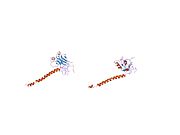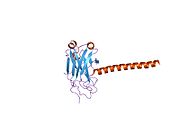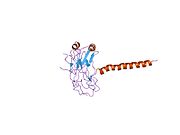Biology:TRAF3
 Generic protein structure example |
TNF receptor-associated factor (TRAF3) is a protein that in humans is encoded by the TRAF3 gene. [1][2][3]
Function
The protein encoded by this gene is a member of the TNF receptor associated factor (TRAF) protein family. TRAF proteins associate with, and mediate the signal transduction from, members of the TNF receptor (TNFR) superfamily. This protein participates in the signal transduction of CD40, a TNFR family member important for the activation of the immune response. This protein is found to be a critical component of the lymphotoxin-beta receptor (LTbetaR) signaling complex, which induces NF-kappaB activation and cell death initiated by LTbeta ligation. Epstein-Barr virus-encoded latent infection membrane protein-1 (LMP1) can interact with this and several other members of the TRAF family, which may be essential for the oncogenic effects of LMP1. Three alternatively spliced transcript variants encoding two distinct isoforms have been reported.[4]
Interactions
TRAF3 has been shown to interact with:
- CD27,[5][6]
- CD40,[7][8][9][10]
- Caspase 3[11][12]
- Lymphotoxin beta receptor,[13][14][15]
- Nucleoporin 62,[16]
- RANK,[17][18]
- TANK,[19][20] and
- TNFSF14.[21]
References
- ↑ "Involvement of CRAF1, a relative of TRAF, in CD40 signaling". Science 267 (5203): 1494–8. March 1995. doi:10.1126/science.7533327. PMID 7533327. Bibcode: 1995Sci...267.1494C.
- ↑ "A novel member of the TRAF family of putative signal transducing proteins binds to the cytosolic domain of CD40". FEBS Letters 358 (2): 113–8. January 1995. doi:10.1016/0014-5793(94)01406-Q. PMID 7530216.
- ↑ "The Epstein-Barr virus transforming protein LMP1 engages signaling proteins for the tumor necrosis factor receptor family". Cell 80 (3): 389–99. February 1995. doi:10.1016/0092-8674(95)90489-1. PMID 7859281.
- ↑ "Entrez Gene: TRAF3 TNF receptor-associated factor 3". https://www.ncbi.nlm.nih.gov/sites/entrez?Db=gene&Cmd=ShowDetailView&TermToSearch=7187.
- ↑ "NF-kappaB activation in CD27 signaling: involvement of TNF receptor-associated factors in its signaling and identification of functional region of CD27". Journal of Immunology 161 (9): 4753–9. November 1998. PMID 9794406.
- ↑ "CD27, a member of the tumor necrosis factor receptor superfamily, activates NF-kappaB and stress-activated protein kinase/c-Jun N-terminal kinase via TRAF2, TRAF5, and NF-kappaB-inducing kinase". The Journal of Biological Chemistry 273 (21): 13353–8. May 1998. doi:10.1074/jbc.273.21.13353. PMID 9582383.
- ↑ "Two differently regulated nuclear factor kappaB activation pathways triggered by the cytoplasmic tail of CD40". Proceedings of the National Academy of Sciences of the United States of America 96 (4): 1234–9. February 1999. doi:10.1073/pnas.96.4.1234. PMID 9990007. Bibcode: 1999PNAS...96.1234T.
- ↑ "A novel RING finger protein interacts with the cytoplasmic domain of CD40". The Journal of Biological Chemistry 269 (48): 30069–72. December 1994. doi:10.1016/S0021-9258(18)43772-6. PMID 7527023.
- ↑ "Molecular basis for CD40 signaling mediated by TRAF3". Proceedings of the National Academy of Sciences of the United States of America 97 (19): 10395–9. September 2000. doi:10.1073/pnas.97.19.10395. PMID 10984535. Bibcode: 2000PNAS...9710395N.
- ↑ "The c-IAP-1 and c-IAP-2 proteins are direct inhibitors of specific caspases". The EMBO Journal 16 (23): 6914–25. December 1997. doi:10.1093/emboj/16.23.6914. PMID 9384571.
- ↑ "Caspase-mediated cleavage of TRAF3 in FasL-stimulated Jurkat-T cells". Journal of Leukocyte Biology 69 (3): 490–6. March 2001. doi:10.1189/jlb.69.3.490. PMID 11261798.
- ↑ "TRAF1 is a substrate of caspases activated during tumor necrosis factor receptor-alpha-induced apoptosis". The Journal of Biological Chemistry 276 (11): 8087–93. March 2001. doi:10.1074/jbc.M009450200. PMID 11098060.
- ↑ "Lymphotoxin-beta receptor signaling complex: role of tumor necrosis factor receptor-associated factor 3 recruitment in cell death and activation of nuclear factor kappaB". Proceedings of the National Academy of Sciences of the United States of America 94 (6): 2460–5. March 1997. doi:10.1073/pnas.94.6.2460. PMID 9122217. Bibcode: 1997PNAS...94.2460V.
- ↑ "The cytoplasmic domain of the lymphotoxin-beta receptor mediates cell death in HeLa cells". The Journal of Biological Chemistry 274 (17): 11868–73. April 1999. doi:10.1074/jbc.274.17.11868. PMID 10207006.
- ↑ "Herpesvirus entry mediator, a member of the tumor necrosis factor receptor (TNFR) family, interacts with members of the TNFR-associated factor family and activates the transcription factors NF-kappaB and AP-1". The Journal of Biological Chemistry 272 (22): 14029–32. May 1997. doi:10.1074/jbc.272.22.14029. PMID 9162022.
- ↑ "TRAF-3 interacts with p62 nucleoporin, a component of the nuclear pore central plug that binds classical NLS-containing import complexes". Molecular Immunology 37 (1–2): 73–84. 2000. doi:10.1016/s0161-5890(00)00015-8. PMID 10781837.
- ↑ "The involvement of multiple tumor necrosis factor receptor (TNFR)-associated factors in the signaling mechanisms of receptor activator of NF-kappaB, a member of the TNFR superfamily". The Journal of Biological Chemistry 273 (51): 34120–7. December 1998. doi:10.1074/jbc.273.51.34120. PMID 9852070.
- ↑ "Receptor activator of NF-kappaB recruits multiple TRAF family adaptors and activates c-Jun N-terminal kinase". FEBS Letters 443 (3): 297–302. January 1999. doi:10.1016/s0014-5793(98)01731-1. PMID 10025951.
- ↑ "A physical and functional map of the human TNF-alpha/NF-kappa B signal transduction pathway". Nature Cell Biology 6 (2): 97–105. February 2004. doi:10.1038/ncb1086. PMID 14743216.
- ↑ "I-TRAF is a novel TRAF-interacting protein that regulates TRAF-mediated signal transduction". Proceedings of the National Academy of Sciences of the United States of America 93 (16): 8241–6. August 1996. doi:10.1073/pnas.93.16.8241. PMID 8710854. Bibcode: 1996PNAS...93.8241R.
- ↑ "Endogenous association of TRAF2, TRAF3, cIAP1, and Smac with lymphotoxin beta receptor reveals a novel mechanism of apoptosis". The Journal of Biological Chemistry 278 (16): 14363–9. April 2003. doi:10.1074/jbc.M208672200. PMID 12571250.
Further reading
- "The TNF-receptor-associated factor family: scaffold molecules for cytokine receptors, kinases and their regulators". Cellular Signalling 13 (6): 389–400. June 2001. doi:10.1016/S0898-6568(01)00160-7. PMID 11384837.
- "Tumor necrosis factor receptor-associated factors (TRAFs)". Oncogene 20 (44): 6482–91. October 2001. doi:10.1038/sj.onc.1204788. PMID 11607847.
- "TRAF3: a new regulator of type I interferons". Cell Cycle 5 (8): 804–7. April 2006. doi:10.4161/cc.5.8.2637. PMID 16582590.
- "A novel RING finger protein interacts with the cytoplasmic domain of CD40". The Journal of Biological Chemistry 269 (48): 30069–72. December 1994. doi:10.1016/S0021-9258(18)43772-6. PMID 7527023.
- "Involvement of CRAF1, a relative of TRAF, in CD40 signaling". Science 267 (5203): 1494–8. March 1995. doi:10.1126/science.7533327. PMID 7533327. Bibcode: 1995Sci...267.1494C.
- "TRADD-TRAF2 and TRADD-FADD interactions define two distinct TNF receptor 1 signal transduction pathways". Cell 84 (2): 299–308. January 1996. doi:10.1016/S0092-8674(00)80984-8. PMID 8565075.
- "TNF-dependent recruitment of the protein kinase RIP to the TNF receptor-1 signaling complex". Immunity 4 (4): 387–96. April 1996. doi:10.1016/S1074-7613(00)80252-6. PMID 8612133.
- "Characterization of ERK1 activation site mutants and the effect on recognition by MEK1 and MEK2". The Journal of Biological Chemistry 271 (8): 4230–5. February 1996. doi:10.1074/jbc.271.8.4230. PMID 8626767.
- "CD30 contains two binding sites with different specificities for members of the tumor necrosis factor receptor-associated factor family of signal transducing proteins". The Journal of Biological Chemistry 271 (22): 12852–8. May 1996. doi:10.1074/jbc.271.22.12852. PMID 8662842.
- "TRAF5, an activator of NF-kappaB and putative signal transducer for the lymphotoxin-beta receptor". The Journal of Biological Chemistry 271 (25): 14661–4. June 1996. doi:10.1074/jbc.271.25.14661. PMID 8663299.
- "I-TRAF is a novel TRAF-interacting protein that regulates TRAF-mediated signal transduction". Proceedings of the National Academy of Sciences of the United States of America 93 (16): 8241–6. August 1996. doi:10.1073/pnas.93.16.8241. PMID 8710854. Bibcode: 1996PNAS...93.8241R.
- "Mammalian CAP interacts with CAP, CAP2, and actin". Journal of Cellular Biochemistry 61 (3): 459–66. June 1996. doi:10.1002/(SICI)1097-4644(19960601)61:3<459::AID-JCB13>3.0.CO;2-E. PMID 8761950.
- "Lymphotoxin-beta receptor signaling complex: role of tumor necrosis factor receptor-associated factor 3 recruitment in cell death and activation of nuclear factor kappaB". Proceedings of the National Academy of Sciences of the United States of America 94 (6): 2460–5. March 1997. doi:10.1073/pnas.94.6.2460. PMID 9122217. Bibcode: 1997PNAS...94.2460V.
- "Herpesvirus entry mediator, a member of the tumor necrosis factor receptor (TNFR) family, interacts with members of the TNFR-associated factor family and activates the transcription factors NF-kappaB and AP-1". The Journal of Biological Chemistry 272 (22): 14029–32. May 1997. doi:10.1074/jbc.272.22.14029. PMID 9162022.
- "Binding sites of cytoplasmic effectors TRAF1, 2, and 3 on CD30 and other members of the TNF receptor superfamily". Biochemical and Biophysical Research Communications 233 (3): 592–600. April 1997. doi:10.1006/bbrc.1997.6509. PMID 9168896.
- "Tumor necrosis factor (TNF)-mediated kinase cascades: bifurcation of nuclear factor-kappaB and c-jun N-terminal kinase (JNK/SAPK) pathways at TNF receptor-associated factor 2". Proceedings of the National Academy of Sciences of the United States of America 94 (18): 9792–6. September 1997. doi:10.1073/pnas.94.18.9792. PMID 9275204. Bibcode: 1997PNAS...94.9792S.
- "Dominant negative mutants of TRAF3 reveal an important role for the coiled coil domains in cell death signaling by the lymphotoxin-beta receptor". The Journal of Biological Chemistry 272 (49): 30835–40. December 1997. doi:10.1074/jbc.272.49.30835. PMID 9388227.








